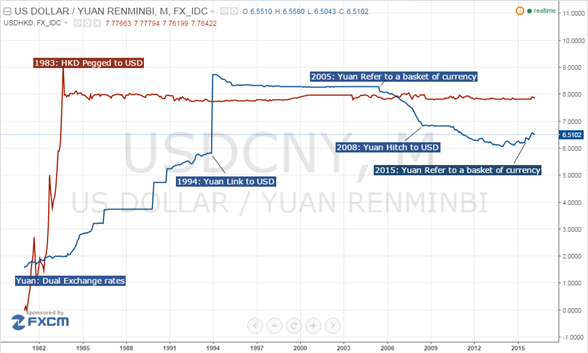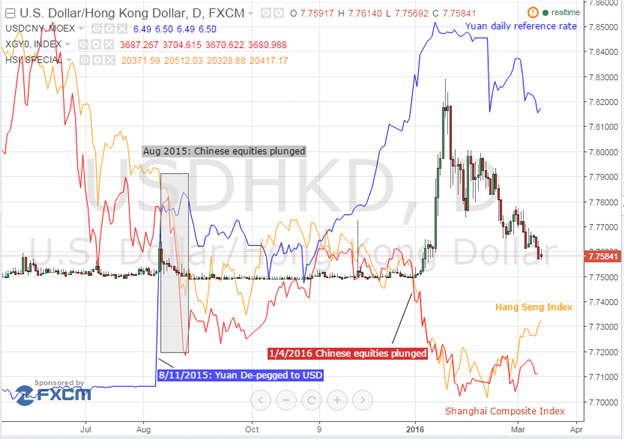Talking points:
- The Hong Kong Dollar maintains a pegged regime to the US Dollar
- The Yuan’s impact on the Hong Kong Dollar has seen a change from 2015 to 2016
- Long-term pressure on HKD’s pegged regime is building between divergent policy approaches
Why It Is Important for Traders
The Yuan’s overnight borrowing rate in Hong Kong (CNH HIBOR) turned negative for the first-time on March 31. Also in the headlines recently, Chinese state-owned brokerage, Guoseng Hong Kong, was in danger of becoming the first State-Owned Enterprises (SEO) to default in Yuan-denominated bonds in an offshore market. In order to understand the concerns these recent events pose for Chinese and global markets, traders will want to take a look at the linked exchange rate and financing systems between the Hong Kong Dollar and the Chinese Yuan.
A Brief History of Hong Kong and Mainland China
Hong Kong is a peninsula located along the southern coast of China. Its adjacent continent is normally referred to as ‘mainland China’. Hong Kong was part of China’s territory until 1842, when it became a British colony. In 1949, the People’s of Republic China (P.R.China) was established and took over control of the mainland. In 1997, the P. R. China (hereinafter referred to as China) took over control of Hong Kong from the British government following more than a century of rule.
This authority change over the past two hundred years led to a unique economic and financial situation between Hong Kong and mainland China - including monetary policy and exchange rate disparities.
One Country, Two Systems
After China took over the sovereignty of Hong Kong in 1997, Hong Kong immediately became an autonomous administration territory under the “one country, two systems” principal. This allows Hong Kong to maintain its currency, the Hong Kong Dollar, and its central bank, the Hong Kong Monetary Authority. Both were established during the British ruling period. On the other hand, in mainland China, The People’s Bank of China serves as the central bank and the official currency is the Chinese Yuan.
The foreign exchange rate regimes for both currencies have changed over time. The HK Dollar was first pegged to the British Pound in 1935 and then became free floating in 1972. In 1983, the HK Dollar was reset to a peg with the US Dollar and has remains so.
The Chinese Yuan was created in 1949 when the country was set up. After the country introduced an “opening up” strategy in the late 1970s, a double exchange rates system was introduced for the currency. In 1994, the two exchange rates were unified and the Chinese Yuan was set to a peg with the US Dollar. In 2005, China’s Central Bank removed the peg and let the Yuan refer to a basket of currencies. After the 2008 global financial crisis, the Yuan was pegged to the US Dollar again in an effort to stabilize the economy. On August 11, 2015, the Central Bank introduced additional reforms on the Yuan and returned the currency to a basket of currencies.

Before 1994, despite of the divergence between the two exchange rates systems, the HK Dollar was not affected much by the Chinese Yuan as the latter was mostly used within mainland China. Over the next 10 years, both currencies were pegged to the US Dollar; thus the link between the two was stable. However, after the Chinese Yuan was de-pegged against the US Dollar last August, the link between the two systems has changed fundamentally.
Two Systems Remain Two
The Hong Kong Monetary Authority (HKMA) set a target rate for USD/HKD at 7.8000 and a tight floating band for the pair between 7.7500 and 7.8500. When the Chinese Yuan was de-pegged from the US Dollar on August 11, 2015; the Hong Kong Dollar moved lower against the US Dollar on the same day but then retraced the losses quickly. By the end of the month, the USD/HKD returned to the low end of the band where it had been before the Yuan’s adjustment – and notably despite the fact that the mainland stock market had plunged over 11% during the month.
At this time, the Hong Kong Dollar – operating under a separate system from the Yuan – may initially enjoy a benefit of capital inflows that bolsters the HKD. When the capital flowed out from mainland China, they may first come to Hong Kong due to the financial links between the countries. That said, funds that were destined for further shores would in turn push the HKD’s value lower against the US Dollar as its primary anchor.
There are a few advantages for mainlanders investing in Hong Kong: it is easy for them to transfer funds to the region under China’s current regulation on the capital account, for example, through the Shanghai-Hong Kong Stock Connect. They can use a wait-and-see strategy and may reinvest back to the mainland market if conditions improve. In September 2015, China’s foreign reserves dropped to $3.514 billion from $3.557 billion in August, while at the same time, Hong Kong’s foreign reserves rose to 345.8 billion from 334.4 billion.

Two Systems Becomes One
However, in January 2016 conditions further changed. The volatility in the Yuan and Chinese financial markets expanded to Hong Kong’s markets and its currency. Yuan’s offshore overnight borrowing rate, HIBOR, soared to 66.8% on January 12after China’s central bank (PBOC) intervened in the effort of squeezing out Yuan short speculations by tightening liquidity at Hong Kong commercial banks. The PBOC’s move at the offshore market, coupled with another plunge in Chinese stocks, has led to investors’ fears that the Hong Kong Dollar may be de-pegged from the US Dollar in the foreseeable future.
In response to the market speculation, Hong Kong Monetary Authority said on January 27 that the regulator will protect HKD’s linked exchange rate regime. Yet, many investors no longer consider Hong Kong as a safe haven as they once had given increasing financial influence by mainland China.
Long-Term Pressure on HKD’s Linked Regime
Through March, the USD/HKD gradually fell back towards the bottom of its range. However, the pressure on the linked exchange rate regime hasn’t permanently vanished.
For one, as discussed above, Hong Kong’s financial markets are highly impacted by mainland China. The Yuan exchange rate as well as China’s equity market remain is in a state of high volatility. During the NPC meeting in fact, issues related to the financial markets were directly in the spotlight.The securities regulator said that they will support the equity market for quite a long time before it regains stability. Thus, the uncertainty in mainland will continue to weigh on Hong Kong markets and its currency.
More importantly, Hong Kong faces a fundamental problem if it retains a linked exchange rate regime. As an important intermediary between Mainland China and the rest of the world, its FX policy approach may conflict with the Yuan’s increasingly market-dependent status. Further, Mainland China, as Hong Kong’s most important trade partner, has been slowing down. At the NPC meeting, China lowered its growth target in 2016 to 6.5% to 7%. The slowdown has been hurting the Hong Kong’s economy as well. In specific, Chinese tourist arrivals to Hong Kong – which is considered a main driver to Hong Kong retail and real estate sectors –have declined significantly over the past months. In January 2016, the total visitor arrival from mainland China shrank by 10% than a year ago. Property prices in Hong Kong dropped by 9.5% over the past six months.
Also, as the US Fed is likely to raise interest rates again in 2016 and then send the US Dollar higher, the linked Hong Kong Dollar would become more expensive than un-pegged currencies including the Chinese Yuan. This will further hurt Hong Kong’s retail and real estate sectors and exports.
It hurts Hong Kong’s financial markets as well. Hong Kong was once the most popular offshore market for mainlanders to issue Yuan-denominated bonds, also called dim-sum bonds. In 2014, the volume of this debt issued in Hong Kong hit a historical high of 205.3 billion yuan, but then it fell to 17 billion yuan in 2015 after the Chinese Yuan was de-pegged against the US Dollar and significantly devalued. Chinese companies now prefer financing from European markets where interest rates are near zero (or even negative) thanks to the ECB’s quantitative easing programs.
Written by Renee Mu, DailyFX Research Team
To receive reports from this analyst, sign up for Renee Mu’ distribution list.
original source















